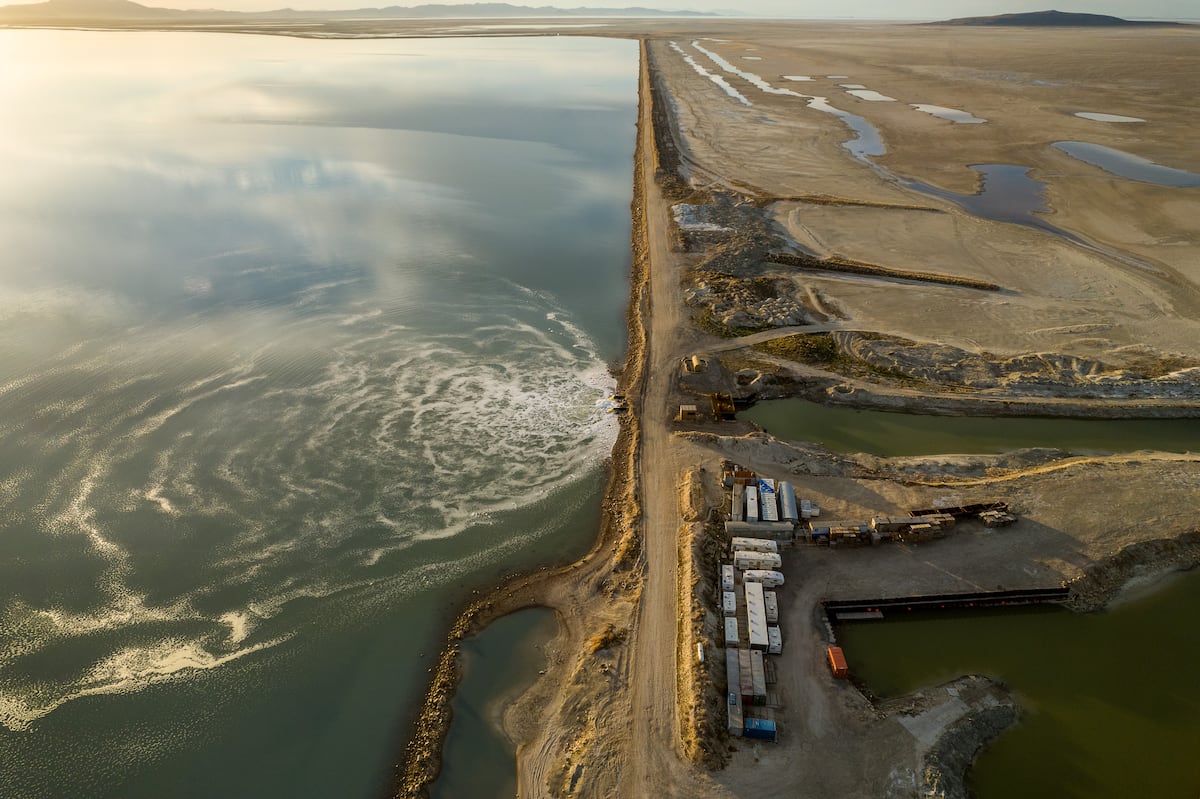Mineral extractors will need to scale back operations as water levels recede.
(Trent Nelson | The Salt Lake Tribune) The US Magnesium dike north of Stansbury Island on Saturday, March 26, 2022.
Utah’s resource managers have presented a plan that ensures water that makes it to the Great Salt Lake stays in the lake.
Lawmakers in 2023 passed legislation taming what they called the “wild west” of minerals extraction on the lake. They also tasked the state engineer, who oversees the Division of Water Rights, with developing a plan that dictates how much brine industries can siphon out of the lake as water elevations drop.
That means that regardless of how much water a mineral company has rights to in the Great Salt Lake, it must curb consumption until the lake reaches a sustainable elevation.
The division presented its draft Distribution Management Plan Friday evening, which outlines different lake levels that trigger reductions.
“Obviously, Great Salt Lake fluctuates over time, sometimes pretty significantly,” said Blake Bingham, deputy state engineer, at the presentation. “This plan has some benchmark elevations.”
Extractors “mine” the Great Salt Lake by pumping its water into shallow solar evaporation ponds that concentrate the brine and make valuable salts easier to remove.
Under the draft plan, mineral companies will continue to make cuts based on who holds the oldest, or most senior, water rights in the lake.
In addition, they will make tiered curtailments to water consumption based on the lake’s health. At a water level of 4,200 feet above sea level, when the lake is considered full, extractors will have no limitations on their rights to lake water. Cuts grow, however, as the water declines. At 4,193 feet, extractors will cease pumping water from the lake entirely unless they have a voluntary agreement with state resource managers.
The lake currently sits at 4,191.9 feet.
The plan considers salinity concentrations and the watershed’s hydrology as well. Lake conditions on June 15 each year determine how much lake water is available to industries starting on the following Jan. 1, regardless of whether wet months follow.
It further ensures “dedicated water,” or water specifically leased or donated to improve the lake’s health, isn’t pumped out by companies and evaporated away.
Utahns can track water accounting for the lake’s water right holders and dedicated water with a new Great Salt Lake Distribution Accounting Tool.
Companies that enter into voluntary agreements with the Department of Natural Resources, with approved change applications from the state engineer, have separate schedules for when and how much water they can use.
The largest mineral extractor to have a voluntary agreement green lit so far is Compass Minerals. Last year, the company donated 121,000 acre-feet of water to the Great Salt Lake in perpetuity, and another 80,000 acre-feet to manage waterfowl habitat on the lake’s fringes.
Compass will also progressively decrease its water diversions after the lake falls below 4,198 feet. It must stop diverting at 4,190 feet.
“By recognizing voluntary agreements,” Utah State Engineer Teresa Wilhelmsen said in a statement, “the state hopes to incentivize businesses to ‘do the right thing’ and give back to the lake.”
Compass previously had enough water rights to deplete as much as 428,000 acre-feet from the Great Salt Lake as long as it has access to the brine. The extractor primarily produces sulfate of potash fertilizers, but it began ramping up operations in 2023 as it prepared to produce lithium.
Lawmakers squelched those plans the following year as they reigned in lake industries. A global glut of lithium made the material’s market value plummet soon after anyway.
Meanwhile, US Magnesium, the lake’s second-largest extractor, ceased operations in 2022 after facings years of declining lake levels, environmental violations and questionable labor practices. It continues to pump water from the Great Salt Lake, however—it used 52,455 acre-feet in 2024 alone, enough water to supply more than 100,000 Utah households, according to information reported to the Division of Water Rights.
The Division of Forestry, Fire and State Lands, which oversees mineral extraction at the Great Salt Lake, declined to comment on US Magnesium’s continued water use due to ongoing litigation.
The Division of Water Rights expects to finalize its Great Salt Lake Distribution Management Plan on Oct. 1 after reviewing public feedback. Comments can be emailed to waterrights@utah.gov.
Note to readers •This article is published through The Great Salt Lake Collaborative: A Solutions Journalism Initiative, a partnership of news, education and media organizations that aims to inform readers about the Great Salt Lake.

